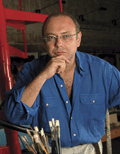How Olympic athletes inspired Tomasz Rut
The art of Tomasz Rut captures the beautiful acts and emotions of mankind with god-like figures that could have descended from Mt. Olympus. As it turns out, the real reasons behind Rut’s style is [...]

1961–
Polish artist Tomasz Rut once said, “I look for inspiration in the humanistic tradition of classical art. My canvases express the entire spectrum of human emotions from exhilaration and cheerfulness to contentment, melancholy, pain, and agony.” He purposely ignores the darker sides of human emotion, focusing on the good or beautiful acts surrounding mankind. Since Rut was just a child, growing up in Poland, he has been preparing himself for his prolific career.
READ MORE +Encouraged by his mother, a painter trained at the Academy of Fine Arts in Warsaw, Rut was introduced to the Pompeian Frescos and the magnificent history of the Renaissance and the Baroque periods as a child. The classical paintings and sculpture inspired his stunning oils, murals, and graphic works. These masterful illusionary images, both in scale and splendor, evoke the harmony and form of the master painters. The flamboyance of Rubens, the finesse of Caravaggio, and the emotion of Michelangelo are Rut’s inspiration.
Training for two semesters at the Pratt Institute in New York, and then in Art Conservation at the Academy of Fine Arts in Warsaw, Rut continued his education, earning a B.A. in Chemistry and Art History and an M.A. in conservation. He eventually took a job in art conservation for the Biltmore House in Asheville, North Carolina, a home owned by the Vanderbilt family with furnishings dating back to the 15th century. He traveled the east coast restoring large scale murals in museums and mansions for such clients as the Smithsonian Institution, the U.S. Treasury Department in Washington, D.C., the New Jersey State House in Trenton, the Gusman Center for the Arts, and Vizcaya Museum in Miami.
It was during these travels he began to notice a void in contemporary art: it was nearly impossible to find and purchase contemporary paintings in a figurative, classical style. It hit him while in Pompeii, like a revelation. The damaged frescos amidst the ruins were more beautiful as faded, ancient relics than they would have been in the 3rd century. Hence, Rut created his aged style of cracked canvasses that so eloquently mimic Italian frescoes and figurative oils. Rut explains that “the one element evident in all of my paintings is the superficial patina or aging,” which Rut creates with a variety of transparent and semi-transparent glazes. This process enhances the naturalistic and expressive qualities of each mythical figure. He claims that without his background in restoration, he never would have visited Pompeii and found this style of painting.
Rut’s studio is integrated into his home. He’ll only paint during daylight hours, although he doesn’t use any natural light. His monochromatic palette seems to reflect artificial light the best, so he keeps the windows closed. Rut paints every day, and it all starts with a vision – something that struck him in an unexpected place. He’ll quickly draw stick figures, choosing not to spend much time on sketching. Once he has his plan in place, Rut brings his models to the studio – even the horses – and draws an outline on canvas. He uses a very restricted palette of only primary colors with old brushes and what he calls “standard” tubes of paint. Stapling a roll of unprimed, un-stretched canvas to the wall, Rut begins painting. When he’s finished, he’ll cut the canvas and begin his aging process, adding a patina to the layers. He can’t say how long the whole process takes because he works on so many paintings at once, but if a piece is on the wall for more than six months, he’ll scrap it.
His imaginary figures – centaurs, fauns, muses, and winged creatures – colorfully burst from the canvas with the grandiosity of Olympian Gods in active and dramatic poses. Since Rut’s father was an Olympic athlete who won a bronze medal in hammer throwing, he was exposed to many athletes – further inspiration for his figures. Through “contrapposto,” earthen monotones, and naturalistic detail, Rut produces images that pay homage to the masters of the high Renaissance while simultaneously creating a place for himself in contemporary art. He echoes their style with his own subjects, using the knowledge built on historical traditions.
His subjects and models are often friends and acquaintances, as well. He keeps his backgrounds plain, using no identifiable marks, and when he plans his compositions, he attempts to choose objects that bring beauty into the world. He does not shy away from controversy but maintains that if his art projects something negative, it must be balanced with something positive.
Rut appreciates the opportunity to extend his message to such a large audience of collectors through Park West and wants to communicate with as many people as he can. He loves taking the opportunity to educate people with little background in art. “My paintings give people the ability to learn, respond, and feel comfortable with the classics,” Rut says. “This gives me enough satisfaction to keep working for a lifetime.”
Rut’s work can be found in the following collections:
Alexander Brest Museum – Jacksonville, Florida
Mississippi Museum of Art – Jackson, Mississippi
Coral Springs Museum of Art – Coral Springs – Florida
The Schacknow Museum of Fine Arts, Inc – Plantation, Florida
Wake Forest University Permanent Art Collection – Winston-Salem, North Carolina
Mobile Museum of Art – Mobile, Alabama
Zigler Museum of Art – Jenninga, Louisiana
Frye Museum of Art – Seattle, Washington
for breaking news, artist updates, and special sale offers